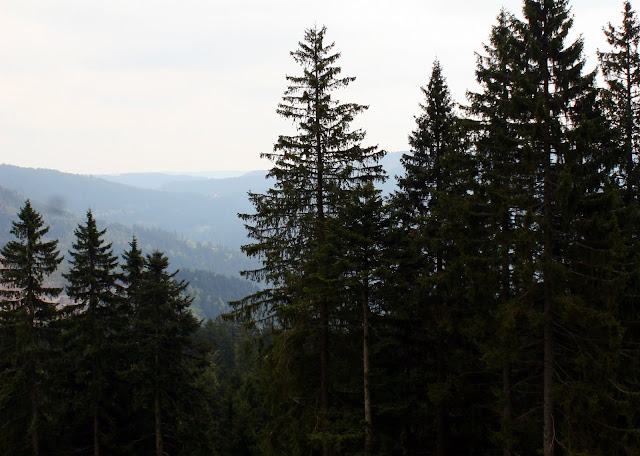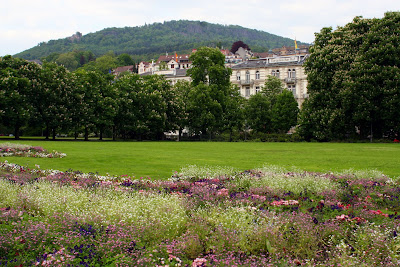We took a weekend trip to Trier, Germany back at the beginning of April, and for whatever reason I have kept on postponing this post week after week. It's not that we didn't enjoy our time in Trier, it's just that with all of our traveling in March and April I got a case of blog backlog and these pictures got buried deeper and deeper in my computer. So, without further ado...
Welcome to Trier! It's like your Rome away from Rome.
The Porta Nigra (Black Gate) is the most famous landmark of the city.
Trier is the oldest city in Germay. It was founded as the ancient Roman town Augusta Trevoreum by Augustus in 15 B.C. The Porta Nigra is all that remains of the 4-mile long city wall, 4 gates, and 47 watch towers that encircled the city.
The structure was built without mortar, so the stones are mostly supported by their own weight with some iron rods thrown in here and there for good measure. Reading about this made me a little nervous to climb up it, but I figure if it's been around this long, then hey what's to worry about? The main reason this gate survived was because it became a church. Nothing much has survived from the church, but we still had fun climbing and poking around.
At the top we got a pretty good view of the city and the surrounding hills covered in vineyards.
Notice anything out of place with this building?
Why hello there floating door on the second floor. It's known as the House of the Three Maji, and it was built in the 13th century as a fortress. A wooden staircase up to the second floor used to be the only way in and out. If there is danger, just burn or tear down the stairs and you've got instant protection.
Below is one side of the Market Square. The square was filled with bustling cafes, outdoor markets and a Weinstube (stand where you can have a glass of the local wine). The tower belongs to the Church of St. Gangolf, the medieval townspeople's church, and it has summoned all drunks to go home when its bell tolls 10:00 every night since the middle ages. If you look above the clock face you'll see a phrase in Latin in golden letters.

Across from the square is the huge St. Peter's Cathedral, the oldest church in Germany. In 1507 the mayor of Trier built the tower on St. Gangolf to make it higher than the one on the cathedral and put the Latin Bible verse from Matthew, "Keep watch and pray." The bishop wasn't too happy about this bold statement by the townsfolk, so he raised one tower of the cathedral and had it adorned with the remainder of the verse: "For you do not know the hour when the Lord will come." The bishop may have gotten the last word, but now the cathedral looks rather silly with one tower taller than the other.
In A.D. 326 Constantine comissioned the building of this St. Peter's Cathedral at the same time as he began construction on St. Peter's in Rome. It is quite a large and impressive place. On one side of the cathedral you can see the different eras of its construction. The red brick section is from the original 4th century construction.
When you walk inside what catches your eye is the illuminated altar at the very back of the cathedral. It holds one of the most highly treasured church relics, the Holy Robe of Jesus Christ, found by St. Helena (the mother of Constantine).
We were disappointed because you can't actually see the robe, but you instead have to rely on these pictures posted by the stairs that lead up to it.
Some perspective: Penelope and I gazing up at the cathedral.
Even though the cathdral is impressive, we were more in awe of the Roman Basilica, which was orignally Constantine's throne room. It's hard to believe that Constantine's thone sat where the altar is now.
It is the largest intact Roman structure outside of Rome. The inside is quite bare of decoration now, but you can imagine the opulance it once held. The wooden beams that make up the ceiling stand out against the stone and brick. To give you an idea of size, each square in the ceiling is 10 ft x 10 ft, which is about the size of a hotel room.
Since 1856 it has been a Lutheran church, but in the 12th century the bishop took over it and converted it to a five-story palace.
And that pink rococo monstrousity tacked on to the front is the Elector's Palace that was added to the basilica in the 18th century. Now it holds the local government offices. Talk about a clash of styles...
The palace redeems itself a bit with these beautiful gardens that stretch out in front.
After a short nap in the Ergo, Penelope was ready to prance around in them.
The gardens extend to this nice grassy park, which leads to another huge Roman construction...
The Imperial Baths.
They were also built by Constantine and kown to be the most intricate bath of the Roman world. Too bad they were never completed. When Constantine left the throne construction stopped.
You can wander around the dark complex of tunnels (almost a mile's worth) that held a two-story subterranean complex of pipes and furnaces that were needed to keep the water at a perfect 120 degrees.(I also found it the perfect enivornment to lull Penelope into her afternoon nap.)
The last Roman attraction we visited was the ampitheater.
It was built around 200 A.D., and crowds of up to 20,000 came to watch gory gladiator and animal fights.
Penelope wanted to see her first gladiator fight, but unfortunately for her there wasn't a show that day.
Then we descended down into the area below the stage where the 'participants' were held before it was their turn to fight.
It was a little creepy.
But we were very brave.
Then we went back up and found the cages where the scary animals were kept. Watch out for lions!
After we'd had our fill of gladiator gore, we traipsed around the vineyards on the surrounding hills and looked for signs that spring was in the air.
Last but not least (and having nothing to do with the Romans) is the Karl Marx House. This is where he was born and grew up, and there is a newly renovated museum inside.
Much to the Father's dismay, I wasn't too interested in purusing the collection of Marx's writings inside, but I was interested in this plaque on the wall because it demonstrated how much German I have learned since we've been here. "In this house on May 5th, 1818, Karl Marx was born."

















































































